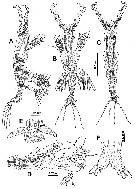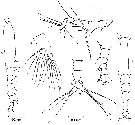|
|
 |
Fiche d'espèce de Copépode |
|
|
Monstrilloida ( Ordre ) |
|
|
|
Monstrillidae ( Famille ) |
|
|
|
Cymbasoma ( Genre ) |
|
|
| |
Cymbasoma tenue (Isaac, 1974) (M) | |
| | | | | | | Syn.: | Thaumaleus tenuis Isaac, 1974 (p.134, Descr.M, figs.M); 1975 (p.7, 9, figs.M); Grygier, 1995 a (p.76) | | | | Ref.: | | | Suarez-Morales & Riccardi, 1997 (p.99, Redescr.M, figs.M, Rem.); Suarez-Morales, 2000 c (p.115, figs.M, Rem.); Vives & Shmeleva, 2010 (p.168, fig.M, Rem.) ; Suarez-Morales, 2011 (p.10); Grygier & Suarez-Morales, 2018 (p.499: Rem.) |  issued from : E. Suarez-Morales & N. Riccardi in Proc. Biol. Soc. Washington, 1997, 110 (1). [p.102, Fig.2]. Male (from Toulon Bay, NW Mediterranean Sea): A, habitus (dorsal); B, idem (lateral); C, cephalic region (dorsal) [arrow indicates protuberance]; D, right A1 (dorsal). Scales in mm. Nota: Cephalic anterior portion wider than body. Cephalothorax about 0.50 % of total body length. Oral papilla located less than 30 % of way back along ventral surface of cephalothorax. Dorsal ocelli present, pigment cups small and widely separated, poorly developed. Cephalic region in dorsal view with one central cuticular protuberance on forehead between pigment cups and paired small sensilla; two strongly chitinized, rounded cuticular processes located posterior to pigmented region of ocelli. A1 4-segmented, length about 37 % of total body length, and about 75 % as long as cephalothorax
|
 issued from : E. Suarez-Morales & N. Riccardi in Proc. Biol. Soc. Washington, 1997, 110 (1). [p.103, Fig.3]. Male: A, P1 (posterior); B, P2 (anterior); C, P3 (postrior); D, P4 (posterior); E, urosome and caudal rami (dorsal); F, genital complex and genital lappets (ventral). Scales in mm. Nota: Urosome consisting of 4 segments; 5th pedigerous somite (with no appendages), genital somite and 2 free somites. Genital somite (in dorsal view) about as long as preanal urosomites, anterior half expanded ventrally.; ratio of lengths of genital somite and two free psterior somites 34.6:23: 40 = 100; subtriangular protuberances on basal portion of each lappets, distally rounded. Caudal rami approximately 1.2 times wider than long, with 3 well developed terminal setae.
|
 issued from : E. Suarez-Morales in Bull. Inst. R. Sci. nat. Belgique, Biologie, 70, 2000. [p.116, Fig.6]. Male (from Toulon Harbor, Mediterranean Sea): A-C, habitus (lateral, ventral and dorsal, respectively); D, right A1 (dorsal); E, genital lappets (ventral view; showing basal denticles, arrowed). Nota: The specimen analysed shows some differences which show additional variation in this species: the forehead is noticeably lower than in the redescription (see Suarez-Morales & Riccardi, 1997), but it has the same type of cuticular corrugation. In both cases, the head abruptly broadens anterior to the oral papilla, although this is more evident in the specimens upon which this species was redescribed. Most importantly, the species is recognized by the structure of its genital lappets with a characteristic pair of sharp denticles on the bases. One of the main differences between this individual and those redescibed from the same locality, is the presence of only 2 caudal setae instead of 3 (as is commonly found in this genus).
|
 issued from : M.J. Isaac in J. mar. biol. Ass. U.K., 1974, 54. [p.134, Fig.6]. As Thaumaleus tenuis. Male (from Gulland Rock, Padstow): A, F, habitus (lateral and dorsal, respectively); B, P4; C, right A1 (ventral); D-E, last thoracic segment and abdomen (ventral and lateral, respectively).
| | | | | Ref. compl.: | | | Jamet & Ferec-Corbel, 1996 (p.17, tab.1: as tenuis) | | | | NZ: | 2 | | |
|
Carte de distribution de Cymbasoma tenue par zones géographiques
|
| | | | | | | Loc: | | | Bristol Channel (off Gulland Rock), NW Medit. (Toulon Harbour) | | | | N: | 4 | | | | Lg.: | | | (278)* M: ± 1,15; (731) M: ± 1,1; (828) M: 0,66-1,15; {M: 0,66-1,15}
* caudal rami excluded. | | | | Rem.: | côtière.
Voir aussi les remarques en anglais | | | Dernière mise à jour : 12/02/2020 | |
|
|
 Toute utilisation de ce site pour une publication sera mentionnée avec la référence suivante : Toute utilisation de ce site pour une publication sera mentionnée avec la référence suivante :
Razouls C., Desreumaux N., Kouwenberg J. et de Bovée F., 2005-2025. - Biodiversité des Copépodes planctoniques marins (morphologie, répartition géographique et données biologiques). Sorbonne Université, CNRS. Disponible sur http://copepodes.obs-banyuls.fr [Accédé le 03 juillet 2025] © copyright 2005-2025 Sorbonne Université, CNRS
|
|
 |
 |







